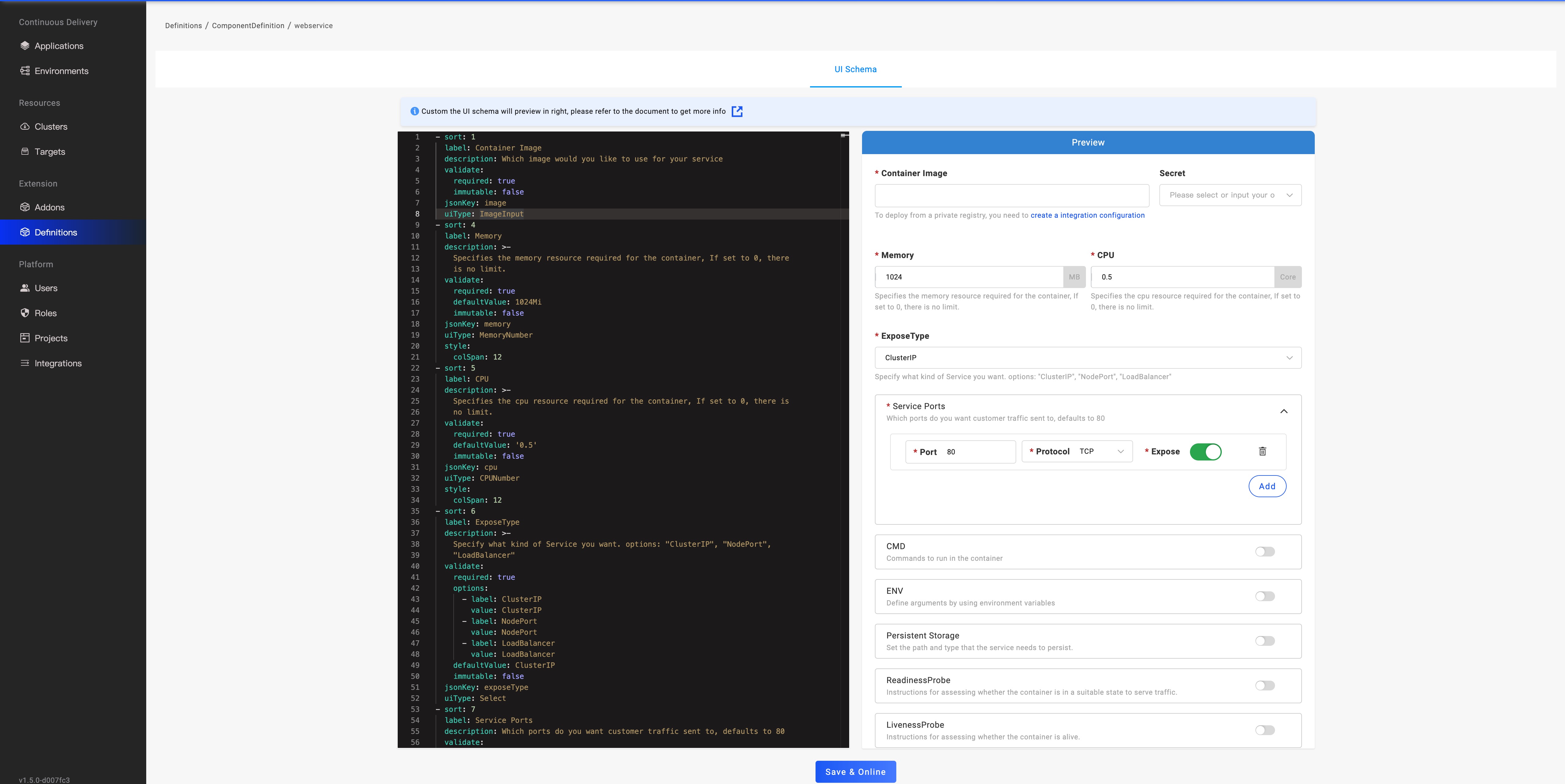8.3 KiB
| title |
|---|
| Custom Container Delivery |
If the default webservice component type is not suitable for your team, and you want to get a more simple way to deploy your business application. This guide will help you. Before, you must have the platform manager's permission.
Simplify the webservice type
The default webservice component type has more than 10 properties. Maybe your developer only needs to configure the image path and resource limits. For the other properties, the team could set the default values.
If so, you could change the webservice definition.
- Change the UI schema to hide some fields
This way is only suitable for the UI users.
On the definition detail page, users could customize the UI schema to setting the UI forms. For example, if you want to hide the ExposeType field, only need to set the disable is true.
...
- jsonKey: exposeType
uiType: Select
label: ExposeType
disable: true
...
More references: UI Schema
- Change the definition and remove or add some fields
If you want to completely remove or add some fields, you should edit the component definition.
This guide should learn the CUE language.
vela def get webservice > custom-webservice.cue
Refer to the CUE Basic and Component Definition documents to learn how to customise the custom-webservice.cue.
After edit:
vela def apply custom-webservice.cue
Create a new component type to deploy the war package
If your team uses the war package to deploy the Java application. In KubeVela you could create a new component type to deploy the War package.
"java-war": {
alias: ""
annotations: {}
attributes: {
workload: {
definition: {
apiVersion: "apps/v1"
kind: "Deployment"
}
type: "deployments.apps"
}
status: {
customStatus: #"""
ready: {
readyReplicas: *0 | int
} & {
if context.output.status.readyReplicas != _|_ {
readyReplicas: context.output.status.readyReplicas
}
}
message: "Ready:\(ready.readyReplicas)/\(context.output.spec.replicas)"
"""#
healthPolicy: #"""
ready: {
updatedReplicas: *0 | int
readyReplicas: *0 | int
replicas: *0 | int
observedGeneration: *0 | int
} & {
if context.output.status.updatedReplicas != _|_ {
updatedReplicas: context.output.status.updatedReplicas
}
if context.output.status.readyReplicas != _|_ {
readyReplicas: context.output.status.readyReplicas
}
if context.output.status.replicas != _|_ {
replicas: context.output.status.replicas
}
if context.output.status.observedGeneration != _|_ {
observedGeneration: context.output.status.observedGeneration
}
}
isHealth: (context.output.spec.replicas == ready.readyReplicas) && (context.output.spec.replicas == ready.updatedReplicas) && (context.output.spec.replicas == ready.replicas) && (ready.observedGeneration == context.output.metadata.generation || ready.observedGeneration > context.output.metadata.generation)
"""#
}
}
description: ""
labels: {}
type: "component"
}
template: {
output: {
apiVersion: "apps/v1"
kind: "Deployment"
metadata: {
name: context.name
namespace: context.namespace
}
spec: {
replicas: parameter.replicas
selector: {
matchLabels: {
"app.oam.dev/component": context.name
}
}
template: {
metadata: {
labels: {
"app.oam.dev/name": context.appName
"app.oam.dev/component": context.name
"app.oam.dev/revision": context.revision
}
}
spec: {
initContainers: [{
name: "prepare-war"
image: "busybox"
if parameter["deployToRoot"] != _|_ {
if parameter["deployToRoot"] {
command: ["wget", "-O", "/usr/local/tomcat/webapps/ROOT.war", parameter["warURL"]]
}
}
if parameter["deployToRoot"] == _|_ {
command: ["wget", "-P", "/usr/local/tomcat/webapps/", parameter["warURL"]]
}
volumeMounts: [{
name: "webapps"
mountPath: "/usr/local/tomcat/webapps"
}]
}]
containers: [{
name: context.name
image: "tomcat:" + parameter["envVersion"]
if parameter["cpu"] != _|_ {
resources: {
limits: cpu: parameter.cpu
requests: cpu: parameter.cpu
}
}
if parameter["memory"] != _|_ {
resources: {
limits: memory: parameter.memory
requests: memory: parameter.memory
}
}
ports: [{
containerPort: 8080
name: "webapp"
}]
_envs: {
custom: *parameter["env"] | []
inner: [
if parameter["javaOpts"] != _|_ {
{
name: "JAVA_OPTS"
value: parameter.javaOpts
}
},
]
}
env: _envs.custom + _envs.inner
volumeMounts: [{
name: "webapps"
mountPath: "/usr/local/tomcat/webapps"
}]
}]
volumes: [{
name: "webapps"
emptyDir: {}
}]
}
}
}
}
outputs: {
services: {
kind: "Service"
apiVersion: "v1"
metadata: {
name: context.name
namespace: context.namespace
}
spec: {
selector: "app.oam.dev/component": context.name
ports: [{
port: 8080
}]
type: "ClusterIP"
}
}
}
parameter: {
// +usage=The URL of the war package.
warURL: string
// +usage=Select a environment version([tomcat version]-[jdk version])
envVersion: *"8-jdk8" | "9-jdk8" | "10-jdk8" | "8-jdk11" | "9-jdk11" | "10-jdk11" | "8-jdk17" | "9-jdk17" | "10-jdk17"
// +usage=Specifies the number of replicas.
replicas: *1 | int
// +usage=Define arguments by using environment variables
env?: [...{
name: string
value?: string
}]
// +usage=Setting the Java Opts configuration.
javaOpts?: string
// +usage=Number of CPU units for the service, like `0.5` (0.5 CPU core), `1` (1 CPU core)
cpu?: string
// +usage=Specifies the attributes of the memory resource required for the container.
memory?: =~"^([1-9][0-9]{0,63})(E|P|T|G|M|K|Ei|Pi|Ti|Gi|Mi|Ki)$"
deployToRoot?: bool
}
}
Copy the definition and create a file java-war.cue, then:
vela def apply java-war.cue
Now, other developers could create the application with a war URL, for example:
apiVersion: core.oam.dev/v1beta1
kind: Application
metadata:
name: nanoservice
namespace: e2e-test
spec:
components:
- name: catalog
properties:
envVersion: 8-jdk8
replicas: 1
warURL: https://static.kubevela.net/example/java-example/nanoservice/catalog.war
type: java-war
- name: customer
properties:
envVersion: 8-jdk8
replicas: 1
warURL: https://static.kubevela.net/example/java-example/nanoservice/customer.war
type: java-war
- dependsOn:
- catalog
- customer
name: order
properties:
env:
- name: CATALOG_HOST
value: catalog
- name: CUSTOMER_HOST
value: customer
envVersion: 8-jdk8
javaOpts: -Xms512m -Xmx512m -Xss256K
replicas: 1
warURL: https://static.kubevela.net/example/java-example/nanoservice/order.war
traits:
- properties:
domains:
- nanoservice.beijing.kubevela.net
rules:
- path:
type: PathPrefix
value: /order
port: 8080
type: http-route
type: java-war
policies:
- name: e2e-test
properties:
clusters:
- local
namespace: e2e-test
type: topology
workflow:
steps:
- name: deploy2-e2e-test
properties:
policies:
- e2e-test
type: deploy
This example includes three components, and the order service depends on the catalog and the customer services. The developer only needs to care about the war package URL and the tomcat/JRE version, they are familiar to the Java developer. The developer should upload the war package to a repository, such as Jfrog. Get a download URL to assign to the warURL field.
In the same way, you could create a component type to deploy the Jar package and other's binary packages.

